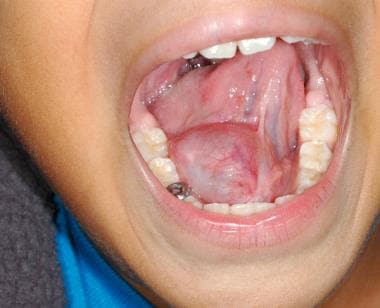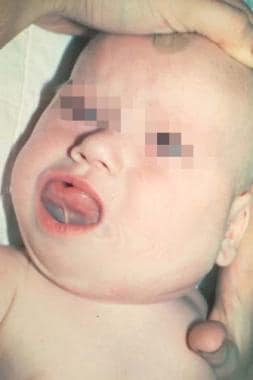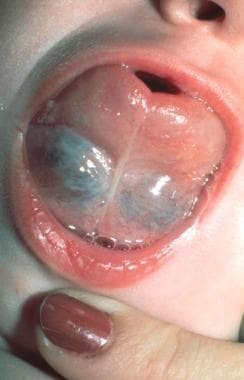Practice Essentials
The term ranula is derived from the Latin word rana, meaning frog, and describes a blue, translucent swelling in the floor of the mouth reminiscent of the underbelly of a frog. The lesions most often appear early in a patient's life, ie, in the first, second, or third decade. Reported ranulas usually exist in association with oral mucoceles. Ranulas may be classified based on their site of presentation into oral, plunging, or mixed lesions. Oral lesions are confined to the floor of mouth. Plunging ranulas occur less commonly than the oral form. [1]
Imaging options for ranula assessment include computed tomography (CT) scanning, ultrasonography, and magnetic resonance imaging (MRI). A variety of surgical approaches exist in the treatment of ranulas, including marsupialization, excision, and removal of the sublingual gland.
Hippocrates described ranulas and thought that they were secondary to inflammation. Paré thought that ranulas may represent descent of brain or pituitary matter.
An image depicting a typical ranula can be seen below.
Workup for ranulas
On CT scanning, ranulas are noted to be sharply demarcated lesions of low attenuation that conform to their local fascial boundaries. With the exception of a sublingual epidermoid, the appearance of a simple ranula on CT scanning is distinctive. [2]
Plunging ranulas are occasionally noted on CT scanning to have a small tail extending into the sublingual space. This finding is almost pathognomonic for plunging ranulas. If this is absent, the presence of a homogeneous cyst in the submandibular or parapharyngeal space that abuts the sublingual space is highly indicative of a plunging ranula.
MRI is the most sensitive imaging study for evaluation of the sublingual gland and its pathologic states.
High-resolution ultrasonography is a noninvasive test with no known biologic cost that has been demonstrated to be quite successful in evaluating cystic lesions of the submandibular region in young people, with particular utility in the plunging ranula. [3]
Management of ranulas
Ranulas can be managed with the following modalities:
-
Marsupialization - Simple marsupialization is the oldest and most widely reported treatment for ranulas
-
Placement of suture or Seton (micro-marsupialization)
-
Carbon dioxide laser treatment
-
Radiation therapy
-
Sublingual gland excision
Plunging ranulas can be treated surgically via a transoral or transcervical approach, although the transoral approach provides better access for complete removal of the sublingual gland.
Epidemiology
Frequency
Ranulas occur infrequently and tend to present early in life, most often in the first, second, or third decade.
Sex
The reported male-to-female ratio is 1:1.3, without significant side preference.
Etiology
Ranulas
Congenital ranulas may arise secondary to an imperforate salivary duct or ostial adhesion. These are quite rare and have been known to spontaneously resolve. [4]
Posttraumatic ranulas arise from (presumed) trauma to the sublingual gland, leading to mucus extravasation and formation of a pseudocyst. The more appropriate term for this may be mucus extravasation reaction (MER).
Plunging ranulas
Plunging ranulas generally appear in conjunction with oral ranulas, although in rare cases they arise independently, without the oral component. Other terms for plunging ranula include deep, diving, cervical, and deep plunging ranula, as well as oral ranula with cervical extension. These lesions are characterized by mucus extravasation, with extension below the mylohyoid muscle and visible extraoral neck swelling. A congenital dehiscence in the mylohyoid muscle has been suggested as an etiology. [5]
Pathophysiology
Ranulas
Ranulas can form as a result of partial obstruction of a sublingual duct, leading to formation of an epithelial-lined retention cyst. This is unusual, occurring in less than 10% of all ranulas.
Ranulas can also result from trauma leading to the formation of extravasated saliva. Experimentally, partial severance or ligation of the sublingual duct leads to ranula formation, whereas ligation of the submandibular duct does not. The ligation of the parotid duct ultimately leads to atrophy. The difference lies in the fact that the sublingual gland secretes continuously in the interdigestive period and appears to be able to secrete against a gradient, whereas the other two major salivary glands secrete only in response to stimuli such as eating. Therefore, with trauma, if the sublingual duct is obstructed, secretory back pressure builds and acini rupture, leading to mucus extravasation. Alternately, trauma causing direct damage to the duct or acini can lead to mucus extravasation, with subsequent pseudocyst formation.
Plunging ranulas
Plunging ranulas arise in the neck by one of 3 mechanisms:
-
The sublingual gland may project through the mylohyoid, or an ectopic sublingual gland may exist on the cervical side of the mylohyoid. This explains most plunging ranulas that exist without an oral component.
-
The pseudocyst may penetrate through the mylohyoid. Up to 27-45% of mylohyoid muscles in cadavers are found to be dehiscent, usually in the anterior two thirds of the muscle. These sites of dehiscence provide a route of egress for the cyst. In some instances, surgical trauma from initial ranula operations may scar or fibrose the superior surface of a ranula. When the ranula recurs, the path of least resistance is through a dehiscent mylohyoid, and a plunging ranula forms when only a simple ranula was present initially. Up to 44% of all plunging ranulas are iatrogenically induced in this manner.
-
A duct from the sublingual gland may join the submandibular gland or its duct, allowing ranulas to form in continuity with the submandibular gland. Therefore, the ranula accesses the neck from behind the mylohyoid muscle.
Presentation
Ranulas
A ranula is most commonly observed as a bluish cyst located below the tongue as seen in the images below. It may fill the mouth and raise the tongue. Typically, these are painless masses that do not change in size in response to chewing, eating, or swallowing. Occasionally, pain may be involved. (See the images below.)
Plunging ranulas
Plunging ranulas can manifest as neck swelling in conjunction with, or independent of, a floor-of-mouth cyst. Occasionally, squeezing the mass causes swelling in the floor-of-mouth cyst. Most reported plunging ranulas are 4-10 cm in size and are usually found in the submandibular space. They have been reported to extend into the submental region, the contralateral neck, the nasopharynx up to the skull base, the retropharynx, and even into the upper mediastinum. [6, 7]
Indications
See Surgical therapy.
Relevant Anatomy
The sublingual gland lies against the sublingual depression of the mandible and directly on the mylohyoid. The submandibular duct (Wharton duct) and the lingual nerve lie posterior and medial to the gland. The genioglossus muscle is medial to these structures. No posterior fascial limits to the sublingual space exist, which allows lesions to exit the sublingual space and enter into the submandibular or parapharyngeal space.
The sublingual gland is unique among the major salivary glands in that it lacks a true capsule and is more consistent with a significant conglomeration of many smaller glands. The sublingual gland is drained by a collective of minor ducts known as the ducts of Rivinus (especially anteriorly), which open into the floor of the mouth, usually along the sublingual fold. At times, several ducts may coalesce and form a more substantive duct termed the Bartholin duct, which often joins the submandibular duct proximal to the sublingual caruncle.
Contraindications
Although some have advocated surgical management of congenital ranulas, recent literature supports observation in asymptomatic patients. Many congenital ranulas resolve on their own and do not require surgical intervention.
Prognosis
Recurrence of the ranula is possible despite surgical excision. Some ranulas have been noted to resolve spontaneously.
-
Ranula. Image courtesy of Sylvan Stool, MD.
-
Ranula. Image courtesy of Sylvan Stool, MD.
-
CT scan of ranula.
-
Intraoperative photo of ranula surgery.
-
Preoperative photo of ranula surgery.
-
Postoperative photo of ranula surgery.









